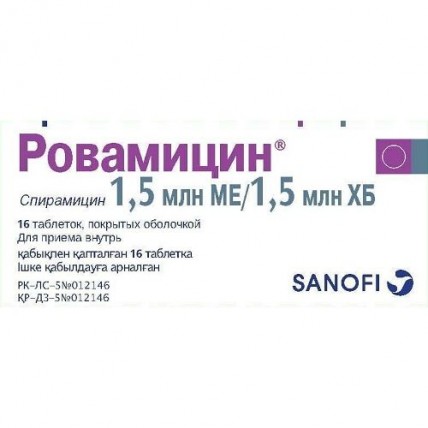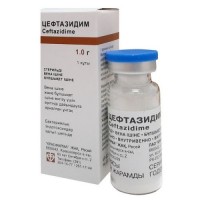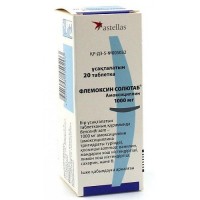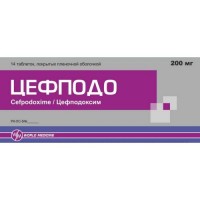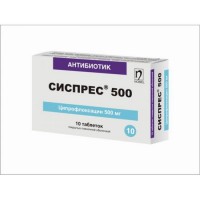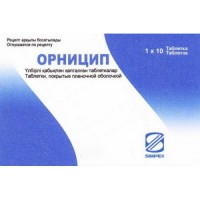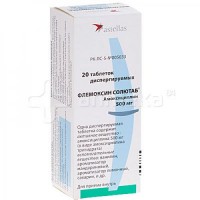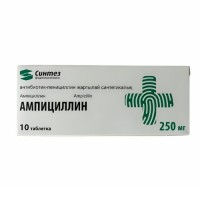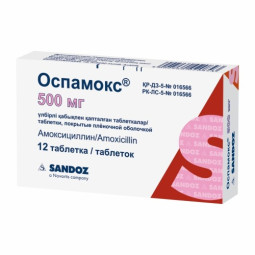Rovamycinum 1500000 IU (16 tablets)
- $20.60
The instruction for medical use
of ROVAMITSIN® medicine
the Trade name
of Rovamitsin®
the International unlicensed
name Spheromycinum Dosage Form
of the Tablet, coated, 1.5 million ME
of the Tablet, coated, 3.0 million ME
Structure
One tablet contains
active agent - Spheromycinum of 1.5 million ME or 3.0 million ME,
excipients: silicon dioxide colloidal anhydrous, magnesium stearate, starch corn prezhelatinizirovanny, the hydroxypropyl cellulose low-substituted sodium of a kroskarmelloz (sodium carboxymethylcellulose), cellulose microcrystalline
structure of a cover: the titan dioxide (E 171), a macrogoal 6000, a gipromelloza
the Description
of the Tablet, coated 1.5 million ME - round biconvex tablets, coated white or cream color with marking of RPR 107 on one party
of the Tablet, coated 3.0 million ME - round biconvex tablets, coated white or cream color with marking of ROVA 3 on one party
Pharmacotherapeutic group
Antibacterial drugs for system use. Macroleads, linkozamida and streptogramina. Macroleads. Spheromycinum
the ATX J01FA02 Code
the Pharmacological
Pharmacokinetics Absorption Spheromycinum properties is soaked up quickly, but not completely. Meal does not influence Spheromycinum absorption.
The maximum concentration in plasma make distribution After intake of 6 million ME of Spheromycinum 3.3 µг/мл. Plasma elimination half-life makes about 8 hours.
Spheromycinum does not get through a blood-brain barrier. However, it gets into breast milk. Binding of proteins of plasma low (10%).
Distribution in fabrics and saliva very high (lungs: from 20 to 60 µг/г, palatine tonsils: from 20 to 80 µг/г, the infected bosoms: from 75 to 110 µг/г, bones: 5-100 µг/г).
In ten days after the termination of treatment µг/г medicinal substance remains from 5 to 7 in a spleen, a liver and kidneys.
Macroleads get and collect in phagocytes (neutrophils, monocytes, peritoneal and alveolar macrophages).
In a human body of concentration of medicinal substance in phagocytes high. These properties explain action of a macrolead on intracellular bacteria.
Metabolism
Spheromycinum is metabolized in a liver, forming chemically unknown, but active metabolites.
Removal
Drug is partially removed with urine (10% of the accepted dose). Removal with bile very high: concentration is 15-40 times higher, than concentration in plasma. The essential amount of Spheromycinum can be revealed in excrements.
A pharmacodynamics
the Range of antimicrobic action
the Critical concentration distinguishing susceptible strains from intermediate strains and also the last strains from resistant strains, are given below:
S ≤ 1 mg/l and R & gt, 4 mg/l.
The prevalence of the acquired resistance at some types can vary in the geographical relation and eventually. Therefore, it is useful to have local information on prevalence of resistance, especially at treatment of heavy infections. These data are only the reference points indicating the probability of susceptibility of a bacterial strain to this antibiotic.
The obtained data on prevalence of resistance of bacterial strains in France are provided in the table below:
The category Frequency of the Acquired Resistance in France (& gt, 10%) (range)
SUSCEPTIBLE TYPES
Gram-positive aerobic microorganisms
of Bacillus cereus Corynebacterium diphtheriae Enterococci
of 50-70%
of Rhodococcus equi Staphylococcus meti-S Staphylococcus meti-R *
70-80%
of Streptococcus B
not classified streptococcus
of 30-40%
of Streptococcus pneumoniae
of 35-70%
of Streptococcus pyogenes
of 16-31%
Gram-negative aerobic microorganisms
of Bordetella pertussis Branhamella catarrhalis Campylobacter Legionella Moraxella
Anaerobic microorganisms
of Actinomyces Bacteroides
of 30-60%
of Eubacterium Mobiluncus Peptostreptococcus
of 30-40%
of Porphyromonas Prevotella Propionibacterium acnes
Different
Borellia burgdorferi Chlamydia Coxiella Leptospires Mycoplasma pneumoniae Treponema pallidum
MODERATELY SUSCEPTIBLE TYPES
(intermediate susceptibility of in vitro)
Gram-negative aerobic microorganisms
of Neisseria gonorrhoeae
Anaerobic microorganisms
of Clostridium perfringens
Different
Ureaplasma urealyticum
RESISTANT TYPES
Gram-positive aerobic microorganisms
of Corynebacterium jeikeium Nocardia asteroids
Gram-negative aerobic microorganisms
of Acinetobacter Enterobacteria Haemophilus Pseudomonas
Aerobic microorganisms
of Fusobacterium
Different
Mycoplasma hominis
Spiramitsin shows activity in relation to Toxoplasma gondii in vitro and in vivo.
* Frequency of resistance of Methicillinum is from about 30 to 50% for all stafilokokk and it is found, mainly, in hospital conditions.
Indications
Therapeutic indications are based on antibacterial activity and pharmacokinetic properties of Spheromycinum. Indications are provided taking into account as the clinical trials executed on this medicine and its places in assortment of the antibacterial agents available now in the market
Use of Spheromycinum is limited to treatment of the infections caused by the microorganisms sensitive to medicine:
- the confirmed pharyngitis caused by a beta and hemolytic streptococcus And as an alternative to treatment by a beta lactam, especially when beta lactams cannot be applied
- acute sinusitis: taking into account microbiological characteristics of these infections use of macroleads is shown when treatment by a beta lactam is impossible
- superinfections of an acute bronchitis
- exacerbation of chronic bronchitis
- community-acquired pneumonia at subjects:
- without risk factors
- without heavy clinical symptoms
- without the clinical factors indicating a pneumococcal etiology
- in the presence of suspicion of atypical pneumonia irrespective of disease severity and the anamnesis
- benign skin infections: impetigo, an ecthyma, an infectious dermo-hypodermitis (especially, erysipelatous inflammation), an erythrasma
- the infection of an oral cavity
- not gonococcal genital infections
- chemoprophylaxis of a recurrence of acute rheumatic fever at patients with an allergy to beta lactams
- toxoplasmosis at pregnant women
needs to take official recommendations for appropriate use of antibacterial agents into account.
A route of administration and doses
to Patients with normal renal function:
Adults: in 2-3 tablets on 3 million ME or 4-6 tablets on 1.5 million ME (daily dose of 6-9 million ME) a day in 2 or 3 receptions.
Children are more senior than 6 years: 1.5-3 one million ME on 10 kg of body weight a day for 2 or 3 receptions.
Duration of treatment of a tonsillitis is 10 days.
Prevention of a spotted fever: for adults 3 million ME/12 of hours, for children 75,000 ME/kg/12 hours within 5 days.
Tablets with a dosage of 3 million ME are not acceptable for children. They are applied only at adults.
To patients with a renal failure:
Correction of a dose is not required.
Route of administration: Tablets need to be swallowed entirely, washing down with a glass of water.
Side effects
- a stomach ache, nausea, vomiting, diarrhea
- rashes, urticaria,
naggers Redko
- passing paresthesia
Very seldom
- pseudomembranous colitis
- a Quincke's disease, an acute anaphylaxis
- sharp generalized exanthematous pustulez (see. Special instructions)
- an aberration of functional trials of a liver
- cases of hemolytic anemia (see. Special instructions)
With an unknown frequency
- the cholestatic, mixed or cytolytic hepatitis
of the Contraindication
- hypersensitivity to Spheromycinum and other components of drug
- the lactation period
Medicinal interactions
of the Combination which need to be taken into account:
- A levodopa (in combination with karbidopy): inhibition of absorption of a karbidopa with the lowered concentration of a levodopa in plasma.
Clinical monitoring and possible correction of dosing of a levodopa.
The particular problems connected with an imbalance INR (the international normalized relation)
It was reported about numerous cases of superactivity of oral anticoagulating means at the patients undergoing therapy by antibiotics. Weight of an infection or inflammation, age of the patient and the general state of health, apparently, are risk factors. Under these circumstances, apparently, it is difficult to define in what degree an infection in itself or its treatment play a role in MNO imbalance. However, some classes of antibiotics are more involved in it, especially: ftorkhinolona, macroleads, tsiklina, co-trimoxazole and some cephalosporins.
Special instructions
If in an initiation of treatment the patients have a generalized erythema and pustules which are followed by a feverish state it is necessary to suspect sharp generalized exanthematous pustulez (see. Side effects). At emergence of similar reaction the treatment needs to be stopped at once, and further treatment by Spheromycinum in the form of monotherapy or in a combination is contraindicated.
Use of a dosage form in the form of tablets for treatment of children is younger than 6 years contraindicated.
As active agent is not removed through kidneys, there is no need to adjust a dose for patients with a renal failure.
About very exceptional cases of hemolytic anemia it was reported concerning patients with insufficiency of glyukozo-6-phosphate-dehydrogenase. Use of Spheromycinum for treatment of these patients, therefore, is not recommended.
Pregnancy and the period of a lactation
Use of Spheromycinum can be considered during pregnancy if necessary. Today wide use of Spheromycinum during pregnancy did not prove the teratogenic or fetotoksichesky impact made by medicine.
Significant amounts of medicine are distinguished in breast milk of the woman. It was reported about gastrointestinal disorders at newborns.
Breastfeeding during use of drug is not recommended.
The feature of influence of medicine on ability to run the vehicle or potentially dangerous mechanisms
does not influence.
Overdose
Symptoms: it is not known about any toxic doses for Spheromycinum.
Gastrointestinal disorders, such as nausea, vomiting and diarrhea can be the symptoms expected at high doses. Cases of the extended QT interval regressing after the treatment termination were noted at newborns, treated by high doses of Spheromycinum and also after intravenous administration of Spheromycinum at patients with risk of lengthening of an interval of QT.
Treatment: there is no specific antidote. In case of overdose Spheromycinum recommends the ECG for measurement of an interval of QT, especially with other risk factors (the hypopotassemia, the congenital extended QTc interval, the accompanying administration of other medicines which extend an interval of QT and/or induce piruetny ventricular tachycardia). Symptomatic treatment is recommended.
A form of release and packing
On 8 tablets of 1.5 million. ME or on 5 tablets of 3.0 million ME in blister strip packagings from a film of polyvinylchloride and aluminum foil. On the 2nd blister strip packagings together with the instruction for medical use in the state and Russian languages put in a pack cardboard.
To Store storage conditions at a temperature not above 25 °C.
To store out of children's reach!
A period of storage
For tablets of 1.5 million ME – 3 years, for tablets of 3 million ME – 4 years.
Not to apply after an expiration date.
Prescription status
According to the prescription
the Producer/packer Famar Lyon, France
the location Address: 29, avenue Charles de Gaulle, 69230 Saint Genis Laval, France
the Owner of the registration certificate
Sanofi-Aventis France, France
the Address of the organization accepting in the territory of the Republic of Kazakhstan claims from consumers on quality of products (goods) of Sanofi-aventis Kazakhstan LLP 050013, Almaty, Furmanov St. 187 Btelefon: +7 (727) 244-50-96факс: +7 (727) 258-25-96e-mail:
To Develop quality.info@sanofi.com
of ROVAMITSIN® medicine
the Trade name
of Rovamitsin®
the International unlicensed
name Spheromycinum Dosage Form
of the Tablet, coated, 1.5 million ME
of the Tablet, coated, 3.0 million ME
Structure
One tablet contains
active agent - Spheromycinum of 1.5 million ME or 3.0 million ME,
excipients: silicon dioxide colloidal anhydrous, magnesium stearate, starch corn prezhelatinizirovanny, the hydroxypropyl cellulose low-substituted sodium of a kroskarmelloz (sodium carboxymethylcellulose), cellulose microcrystalline
structure of a cover: the titan dioxide (E 171), a macrogoal 6000, a gipromelloza
the Description
of the Tablet, coated 1.5 million ME - round biconvex tablets, coated white or cream color with marking of RPR 107 on one party
of the Tablet, coated 3.0 million ME - round biconvex tablets, coated white or cream color with marking of ROVA 3 on one party
Pharmacotherapeutic group
Antibacterial drugs for system use. Macroleads, linkozamida and streptogramina. Macroleads. Spheromycinum
the ATX J01FA02 Code
the Pharmacological
Pharmacokinetics Absorption Spheromycinum properties is soaked up quickly, but not completely. Meal does not influence Spheromycinum absorption.
The maximum concentration in plasma make distribution After intake of 6 million ME of Spheromycinum 3.3 µг/мл. Plasma elimination half-life makes about 8 hours.
Spheromycinum does not get through a blood-brain barrier. However, it gets into breast milk. Binding of proteins of plasma low (10%).
Distribution in fabrics and saliva very high (lungs: from 20 to 60 µг/г, palatine tonsils: from 20 to 80 µг/г, the infected bosoms: from 75 to 110 µг/г, bones: 5-100 µг/г).
In ten days after the termination of treatment µг/г medicinal substance remains from 5 to 7 in a spleen, a liver and kidneys.
Macroleads get and collect in phagocytes (neutrophils, monocytes, peritoneal and alveolar macrophages).
In a human body of concentration of medicinal substance in phagocytes high. These properties explain action of a macrolead on intracellular bacteria.
Metabolism
Spheromycinum is metabolized in a liver, forming chemically unknown, but active metabolites.
Removal
Drug is partially removed with urine (10% of the accepted dose). Removal with bile very high: concentration is 15-40 times higher, than concentration in plasma. The essential amount of Spheromycinum can be revealed in excrements.
A pharmacodynamics
the Range of antimicrobic action
the Critical concentration distinguishing susceptible strains from intermediate strains and also the last strains from resistant strains, are given below:
S ≤ 1 mg/l and R & gt, 4 mg/l.
The prevalence of the acquired resistance at some types can vary in the geographical relation and eventually. Therefore, it is useful to have local information on prevalence of resistance, especially at treatment of heavy infections. These data are only the reference points indicating the probability of susceptibility of a bacterial strain to this antibiotic.
The obtained data on prevalence of resistance of bacterial strains in France are provided in the table below:
The category Frequency of the Acquired Resistance in France (& gt, 10%) (range)
SUSCEPTIBLE TYPES
Gram-positive aerobic microorganisms
of Bacillus cereus Corynebacterium diphtheriae Enterococci
of 50-70%
of Rhodococcus equi Staphylococcus meti-S Staphylococcus meti-R *
70-80%
of Streptococcus B
not classified streptococcus
of 30-40%
of Streptococcus pneumoniae
of 35-70%
of Streptococcus pyogenes
of 16-31%
Gram-negative aerobic microorganisms
of Bordetella pertussis Branhamella catarrhalis Campylobacter Legionella Moraxella
Anaerobic microorganisms
of Actinomyces Bacteroides
of 30-60%
of Eubacterium Mobiluncus Peptostreptococcus
of 30-40%
of Porphyromonas Prevotella Propionibacterium acnes
Different
Borellia burgdorferi Chlamydia Coxiella Leptospires Mycoplasma pneumoniae Treponema pallidum
MODERATELY SUSCEPTIBLE TYPES
(intermediate susceptibility of in vitro)
Gram-negative aerobic microorganisms
of Neisseria gonorrhoeae
Anaerobic microorganisms
of Clostridium perfringens
Different
Ureaplasma urealyticum
RESISTANT TYPES
Gram-positive aerobic microorganisms
of Corynebacterium jeikeium Nocardia asteroids
Gram-negative aerobic microorganisms
of Acinetobacter Enterobacteria Haemophilus Pseudomonas
Aerobic microorganisms
of Fusobacterium
Different
Mycoplasma hominis
Spiramitsin shows activity in relation to Toxoplasma gondii in vitro and in vivo.
* Frequency of resistance of Methicillinum is from about 30 to 50% for all stafilokokk and it is found, mainly, in hospital conditions.
Indications
Therapeutic indications are based on antibacterial activity and pharmacokinetic properties of Spheromycinum. Indications are provided taking into account as the clinical trials executed on this medicine and its places in assortment of the antibacterial agents available now in the market
Use of Spheromycinum is limited to treatment of the infections caused by the microorganisms sensitive to medicine:
- the confirmed pharyngitis caused by a beta and hemolytic streptococcus And as an alternative to treatment by a beta lactam, especially when beta lactams cannot be applied
- acute sinusitis: taking into account microbiological characteristics of these infections use of macroleads is shown when treatment by a beta lactam is impossible
- superinfections of an acute bronchitis
- exacerbation of chronic bronchitis
- community-acquired pneumonia at subjects:
- without risk factors
- without heavy clinical symptoms
- without the clinical factors indicating a pneumococcal etiology
- in the presence of suspicion of atypical pneumonia irrespective of disease severity and the anamnesis
- benign skin infections: impetigo, an ecthyma, an infectious dermo-hypodermitis (especially, erysipelatous inflammation), an erythrasma
- the infection of an oral cavity
- not gonococcal genital infections
- chemoprophylaxis of a recurrence of acute rheumatic fever at patients with an allergy to beta lactams
- toxoplasmosis at pregnant women
needs to take official recommendations for appropriate use of antibacterial agents into account.
A route of administration and doses
to Patients with normal renal function:
Adults: in 2-3 tablets on 3 million ME or 4-6 tablets on 1.5 million ME (daily dose of 6-9 million ME) a day in 2 or 3 receptions.
Children are more senior than 6 years: 1.5-3 one million ME on 10 kg of body weight a day for 2 or 3 receptions.
Duration of treatment of a tonsillitis is 10 days.
Prevention of a spotted fever: for adults 3 million ME/12 of hours, for children 75,000 ME/kg/12 hours within 5 days.
Tablets with a dosage of 3 million ME are not acceptable for children. They are applied only at adults.
To patients with a renal failure:
Correction of a dose is not required.
Route of administration: Tablets need to be swallowed entirely, washing down with a glass of water.
Side effects
- a stomach ache, nausea, vomiting, diarrhea
- rashes, urticaria,
naggers Redko
- passing paresthesia
Very seldom
- pseudomembranous colitis
- a Quincke's disease, an acute anaphylaxis
- sharp generalized exanthematous pustulez (see. Special instructions)
- an aberration of functional trials of a liver
- cases of hemolytic anemia (see. Special instructions)
With an unknown frequency
- the cholestatic, mixed or cytolytic hepatitis
of the Contraindication
- hypersensitivity to Spheromycinum and other components of drug
- the lactation period
Medicinal interactions
of the Combination which need to be taken into account:
- A levodopa (in combination with karbidopy): inhibition of absorption of a karbidopa with the lowered concentration of a levodopa in plasma.
Clinical monitoring and possible correction of dosing of a levodopa.
The particular problems connected with an imbalance INR (the international normalized relation)
It was reported about numerous cases of superactivity of oral anticoagulating means at the patients undergoing therapy by antibiotics. Weight of an infection or inflammation, age of the patient and the general state of health, apparently, are risk factors. Under these circumstances, apparently, it is difficult to define in what degree an infection in itself or its treatment play a role in MNO imbalance. However, some classes of antibiotics are more involved in it, especially: ftorkhinolona, macroleads, tsiklina, co-trimoxazole and some cephalosporins.
Special instructions
If in an initiation of treatment the patients have a generalized erythema and pustules which are followed by a feverish state it is necessary to suspect sharp generalized exanthematous pustulez (see. Side effects). At emergence of similar reaction the treatment needs to be stopped at once, and further treatment by Spheromycinum in the form of monotherapy or in a combination is contraindicated.
Use of a dosage form in the form of tablets for treatment of children is younger than 6 years contraindicated.
As active agent is not removed through kidneys, there is no need to adjust a dose for patients with a renal failure.
About very exceptional cases of hemolytic anemia it was reported concerning patients with insufficiency of glyukozo-6-phosphate-dehydrogenase. Use of Spheromycinum for treatment of these patients, therefore, is not recommended.
Pregnancy and the period of a lactation
Use of Spheromycinum can be considered during pregnancy if necessary. Today wide use of Spheromycinum during pregnancy did not prove the teratogenic or fetotoksichesky impact made by medicine.
Significant amounts of medicine are distinguished in breast milk of the woman. It was reported about gastrointestinal disorders at newborns.
Breastfeeding during use of drug is not recommended.
The feature of influence of medicine on ability to run the vehicle or potentially dangerous mechanisms
does not influence.
Overdose
Symptoms: it is not known about any toxic doses for Spheromycinum.
Gastrointestinal disorders, such as nausea, vomiting and diarrhea can be the symptoms expected at high doses. Cases of the extended QT interval regressing after the treatment termination were noted at newborns, treated by high doses of Spheromycinum and also after intravenous administration of Spheromycinum at patients with risk of lengthening of an interval of QT.
Treatment: there is no specific antidote. In case of overdose Spheromycinum recommends the ECG for measurement of an interval of QT, especially with other risk factors (the hypopotassemia, the congenital extended QTc interval, the accompanying administration of other medicines which extend an interval of QT and/or induce piruetny ventricular tachycardia). Symptomatic treatment is recommended.
A form of release and packing
On 8 tablets of 1.5 million. ME or on 5 tablets of 3.0 million ME in blister strip packagings from a film of polyvinylchloride and aluminum foil. On the 2nd blister strip packagings together with the instruction for medical use in the state and Russian languages put in a pack cardboard.
To Store storage conditions at a temperature not above 25 °C.
To store out of children's reach!
A period of storage
For tablets of 1.5 million ME – 3 years, for tablets of 3 million ME – 4 years.
Not to apply after an expiration date.
Prescription status
According to the prescription
the Producer/packer Famar Lyon, France
the location Address: 29, avenue Charles de Gaulle, 69230 Saint Genis Laval, France
the Owner of the registration certificate
Sanofi-Aventis France, France
the Address of the organization accepting in the territory of the Republic of Kazakhstan claims from consumers on quality of products (goods) of Sanofi-aventis Kazakhstan LLP 050013, Almaty, Furmanov St. 187 Btelefon: +7 (727) 244-50-96факс: +7 (727) 258-25-96e-mail:
To Develop quality.info@sanofi.com
